6.1: Primal And Subprimal Cuts of Pork
- Page ID
- 21248
\( \newcommand{\vecs}[1]{\overset { \scriptstyle \rightharpoonup} {\mathbf{#1}} } \)
\( \newcommand{\vecd}[1]{\overset{-\!-\!\rightharpoonup}{\vphantom{a}\smash {#1}}} \)
\( \newcommand{\id}{\mathrm{id}}\) \( \newcommand{\Span}{\mathrm{span}}\)
( \newcommand{\kernel}{\mathrm{null}\,}\) \( \newcommand{\range}{\mathrm{range}\,}\)
\( \newcommand{\RealPart}{\mathrm{Re}}\) \( \newcommand{\ImaginaryPart}{\mathrm{Im}}\)
\( \newcommand{\Argument}{\mathrm{Arg}}\) \( \newcommand{\norm}[1]{\| #1 \|}\)
\( \newcommand{\inner}[2]{\langle #1, #2 \rangle}\)
\( \newcommand{\Span}{\mathrm{span}}\)
\( \newcommand{\id}{\mathrm{id}}\)
\( \newcommand{\Span}{\mathrm{span}}\)
\( \newcommand{\kernel}{\mathrm{null}\,}\)
\( \newcommand{\range}{\mathrm{range}\,}\)
\( \newcommand{\RealPart}{\mathrm{Re}}\)
\( \newcommand{\ImaginaryPart}{\mathrm{Im}}\)
\( \newcommand{\Argument}{\mathrm{Arg}}\)
\( \newcommand{\norm}[1]{\| #1 \|}\)
\( \newcommand{\inner}[2]{\langle #1, #2 \rangle}\)
\( \newcommand{\Span}{\mathrm{span}}\) \( \newcommand{\AA}{\unicode[.8,0]{x212B}}\)
\( \newcommand{\vectorA}[1]{\vec{#1}} % arrow\)
\( \newcommand{\vectorAt}[1]{\vec{\text{#1}}} % arrow\)
\( \newcommand{\vectorB}[1]{\overset { \scriptstyle \rightharpoonup} {\mathbf{#1}} } \)
\( \newcommand{\vectorC}[1]{\textbf{#1}} \)
\( \newcommand{\vectorD}[1]{\overrightarrow{#1}} \)
\( \newcommand{\vectorDt}[1]{\overrightarrow{\text{#1}}} \)
\( \newcommand{\vectE}[1]{\overset{-\!-\!\rightharpoonup}{\vphantom{a}\smash{\mathbf {#1}}}} \)
\( \newcommand{\vecs}[1]{\overset { \scriptstyle \rightharpoonup} {\mathbf{#1}} } \)
\( \newcommand{\vecd}[1]{\overset{-\!-\!\rightharpoonup}{\vphantom{a}\smash {#1}}} \)
\(\newcommand{\avec}{\mathbf a}\) \(\newcommand{\bvec}{\mathbf b}\) \(\newcommand{\cvec}{\mathbf c}\) \(\newcommand{\dvec}{\mathbf d}\) \(\newcommand{\dtil}{\widetilde{\mathbf d}}\) \(\newcommand{\evec}{\mathbf e}\) \(\newcommand{\fvec}{\mathbf f}\) \(\newcommand{\nvec}{\mathbf n}\) \(\newcommand{\pvec}{\mathbf p}\) \(\newcommand{\qvec}{\mathbf q}\) \(\newcommand{\svec}{\mathbf s}\) \(\newcommand{\tvec}{\mathbf t}\) \(\newcommand{\uvec}{\mathbf u}\) \(\newcommand{\vvec}{\mathbf v}\) \(\newcommand{\wvec}{\mathbf w}\) \(\newcommand{\xvec}{\mathbf x}\) \(\newcommand{\yvec}{\mathbf y}\) \(\newcommand{\zvec}{\mathbf z}\) \(\newcommand{\rvec}{\mathbf r}\) \(\newcommand{\mvec}{\mathbf m}\) \(\newcommand{\zerovec}{\mathbf 0}\) \(\newcommand{\onevec}{\mathbf 1}\) \(\newcommand{\real}{\mathbb R}\) \(\newcommand{\twovec}[2]{\left[\begin{array}{r}#1 \\ #2 \end{array}\right]}\) \(\newcommand{\ctwovec}[2]{\left[\begin{array}{c}#1 \\ #2 \end{array}\right]}\) \(\newcommand{\threevec}[3]{\left[\begin{array}{r}#1 \\ #2 \\ #3 \end{array}\right]}\) \(\newcommand{\cthreevec}[3]{\left[\begin{array}{c}#1 \\ #2 \\ #3 \end{array}\right]}\) \(\newcommand{\fourvec}[4]{\left[\begin{array}{r}#1 \\ #2 \\ #3 \\ #4 \end{array}\right]}\) \(\newcommand{\cfourvec}[4]{\left[\begin{array}{c}#1 \\ #2 \\ #3 \\ #4 \end{array}\right]}\) \(\newcommand{\fivevec}[5]{\left[\begin{array}{r}#1 \\ #2 \\ #3 \\ #4 \\ #5 \\ \end{array}\right]}\) \(\newcommand{\cfivevec}[5]{\left[\begin{array}{c}#1 \\ #2 \\ #3 \\ #4 \\ #5 \\ \end{array}\right]}\) \(\newcommand{\mattwo}[4]{\left[\begin{array}{rr}#1 \amp #2 \\ #3 \amp #4 \\ \end{array}\right]}\) \(\newcommand{\laspan}[1]{\text{Span}\{#1\}}\) \(\newcommand{\bcal}{\cal B}\) \(\newcommand{\ccal}{\cal C}\) \(\newcommand{\scal}{\cal S}\) \(\newcommand{\wcal}{\cal W}\) \(\newcommand{\ecal}{\cal E}\) \(\newcommand{\coords}[2]{\left\{#1\right\}_{#2}}\) \(\newcommand{\gray}[1]{\color{gray}{#1}}\) \(\newcommand{\lgray}[1]{\color{lightgray}{#1}}\) \(\newcommand{\rank}{\operatorname{rank}}\) \(\newcommand{\row}{\text{Row}}\) \(\newcommand{\col}{\text{Col}}\) \(\renewcommand{\row}{\text{Row}}\) \(\newcommand{\nul}{\text{Nul}}\) \(\newcommand{\var}{\text{Var}}\) \(\newcommand{\corr}{\text{corr}}\) \(\newcommand{\len}[1]{\left|#1\right|}\) \(\newcommand{\bbar}{\overline{\bvec}}\) \(\newcommand{\bhat}{\widehat{\bvec}}\) \(\newcommand{\bperp}{\bvec^\perp}\) \(\newcommand{\xhat}{\widehat{\xvec}}\) \(\newcommand{\vhat}{\widehat{\vvec}}\) \(\newcommand{\uhat}{\widehat{\uvec}}\) \(\newcommand{\what}{\widehat{\wvec}}\) \(\newcommand{\Sighat}{\widehat{\Sigma}}\) \(\newcommand{\lt}{<}\) \(\newcommand{\gt}{>}\) \(\newcommand{\amp}{&}\) \(\definecolor{fillinmathshade}{gray}{0.9}\)After a hog is slaughtered, it is generally split down the backbone, dividing the carcass into bilateral halves. Like the beef carcass, each side of the hog carcass is then further broken down into the primal cuts: shoulder, Boston butt, belly, loin and fresh ham.
Hogs are bred specifically to produce long loins; the loin contains the highest- quality meat and is the most expensive cut of pork. Pork is unique in that the ribs and loin are considered a single primal. They are not separated into two different primals, as are the ribs and loin of beef, veal and lamb. As with all meats, it is important to know the location of bones when cutting or working with pork. This makes meat fabrication and carving easier and aids in identifying cuts. A hog carcass generally weighs in a range of 120 to 210 pounds (55 to 110 kg)
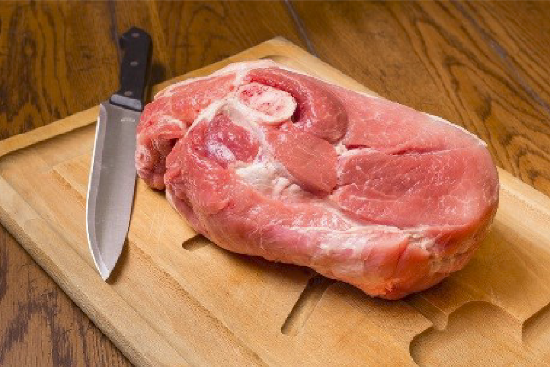
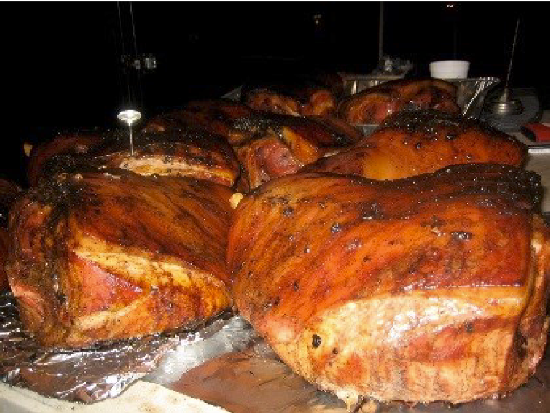
Raw pork shoulder- flickr.com BBQ pork shoulder- Wikimedia.org
The primal shoulder, known as the picnic ham, is the lower portion of the hog's foreleg; it accounts for approximately 20 percent of the carcass weight. The shoulder contains the arm and shank bones and has a relatively high ratio of bone to lean meat.
Because all pork comes from hogs slaughtered at a young age, the shoulder is tender enough to be cooked by any method. It is, however, one of the least tender cuts of pork. It is available smoked or fresh. The shoulder is fairly inexpensive and, when purchased fresh, it can be cut into shoulder butt steaks or boned and cut into smaller pieces for sautéing or stewing. Whole pork shoulder is the cut preferred by many barbecue pit masters throughout the American South.
The foreshank is called the shoulder hock and is usually smoked. Shoulder hocks are often simmered for long periods in soups, stews and braised dishes to add flavor and richness.
BOSTON BUTT
The primal Boston butt is a square cut located just above the primal pork shoulder. It accounts for approximately 7 percent of the carcass weight.
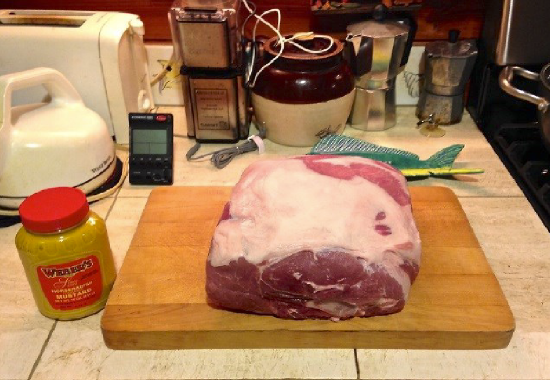
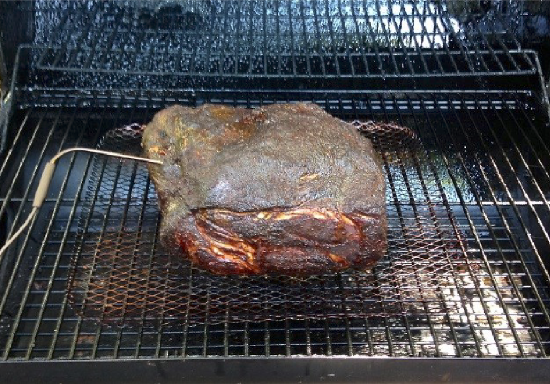
Raw Boston Butt roast- Flickr.com Smoked Boston Butt- flickr.com
The Boston butt is very meaty and tender, with a good percentage of fat to lean meat. Containing only a small portion of the blade bone, the Boston butt is a good choice when a recipe calls for a solid piece of lean pork. The fresh Boston butt is sometimes cut into steaks, or chops to be broiled or sautéed. When the Boston butt is smoked, it is usually boneless and called a cottage ham.
BELLY
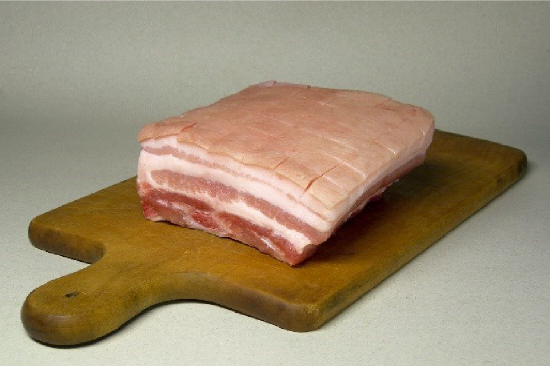
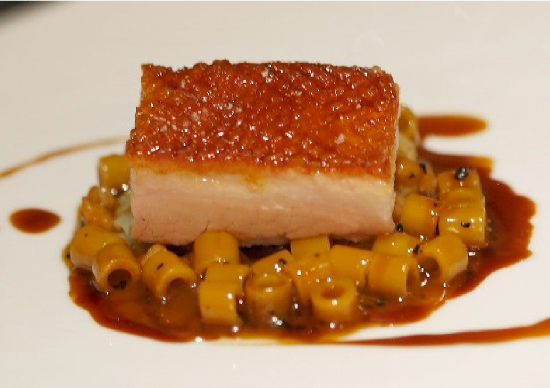
Raw pork belly- Wikimedia commons Braised pork belly- Wikimedia commons
The primal pork belly is located below the loin. Accounting for approximately 16 percent of the carcass weight, it is very fatty with only streaks of lean meat. It contains the spareribs, which are always separated from the rest of the belly before cooking. Spareribs usually are sold fresh but can also be smoked. Typically, they are simmered, and then grilled, or baked, while being basted with a spicy barbecue sauce. The remainder of the pork belly is nearly always cured and smoked to produce bacon.
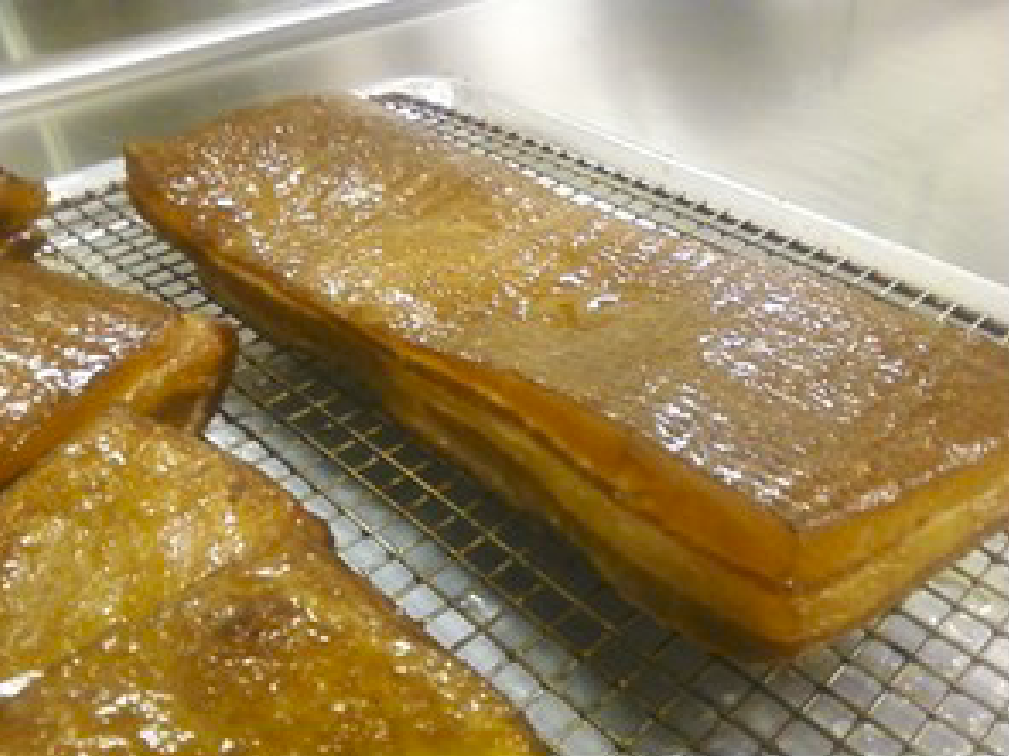
Maple bacon- photo credit Chef Marshall Welsh CEC
LOIN
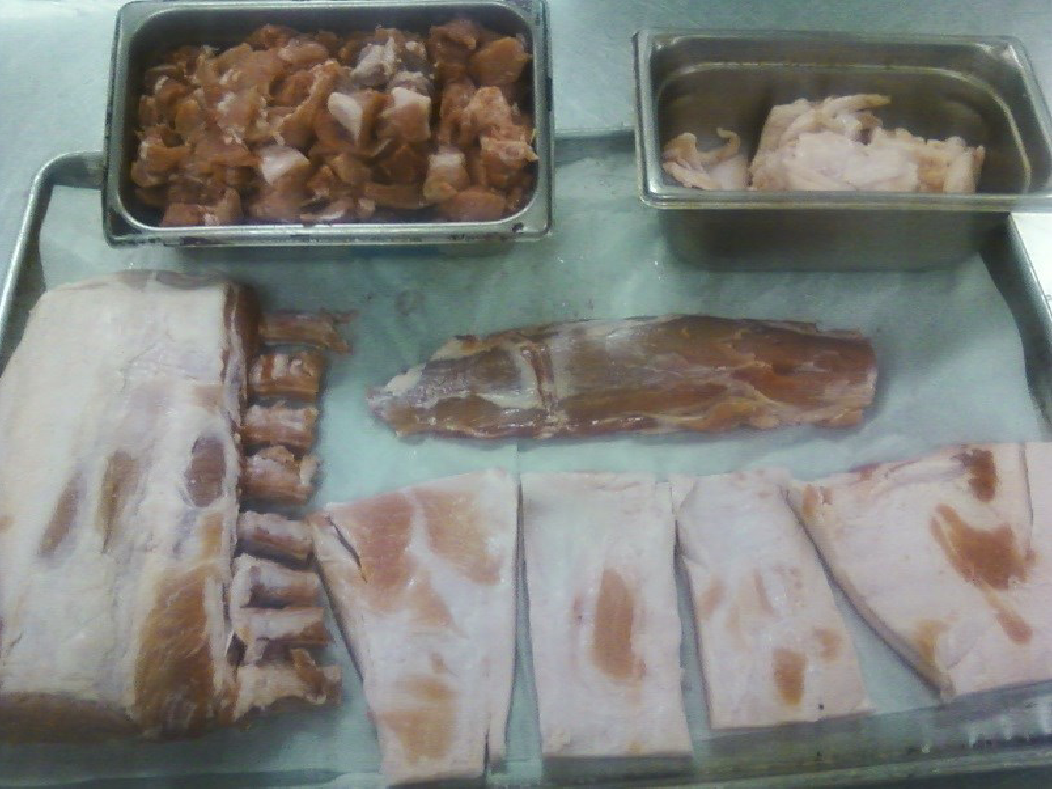
Pork cuts from loin- photo credit Chef Marshall Welsh CEC Above from far left and counter clockwise to center: Bone-in pork loin partially frenched, pork trim, fat trim, pork tenderloin (center), plate or back fat (lower center to right).
The loin is cut from directly behind the Boston butt and includes the entire rib section as well as the loin and a portion of the sirloin area. The primal loin accounts for approximately 20 percent of the carcass weight. It contains a portion of the blade bone on the shoulder end, a portion of the hipbone on the ham end, all the ribs and most of the backbone.
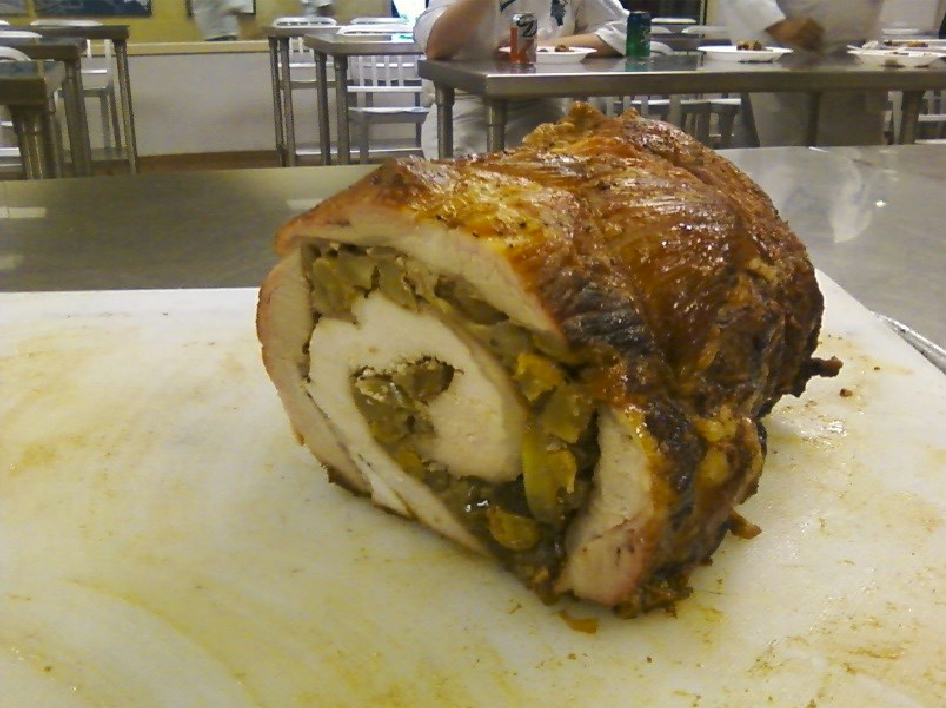
Stuffed Roll of Pork lion- photo credit Chef Marshall Welsh CEC
The primal pork loin is the only primal cut of pork not typically smoked or cured. Most of the loin is a single, very tender eye muscle. It is quite lean but contains enough intramuscular and subcutaneous fat to make it an excellent choice for a moist-heat cooking method such as braising, or it can be prepared with dry-heat cooking methods such as roasting or sautéing. The loin also contains the pork tenderloin, located on the inside of the rib bones on the sirloin end of the loin. The tenderloin is the tenderest cut of pork; it is very versatile and can be trimmed, cut into medallions and sautéed, or the whole tenderloin can be roasted or braised. The most popular cut from the loin is the pork chop. Chops can be cut from the entire loin, the choicest being center-cut chops from the primal loin after the blade bone and sirloin portions at the front and rear of the loin are removed. The pork loin can be purchased boneless or boned and tied as a roast. A boneless pork loin is smoked to produce Canadian bacon. The rib bones, when trimmed from the loin, can be served as barbecued pork back ribs.
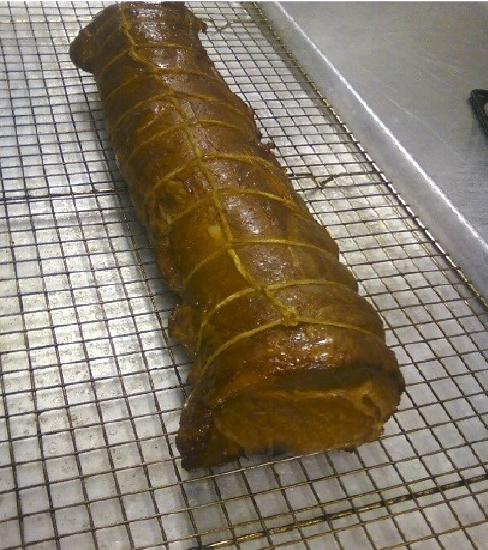
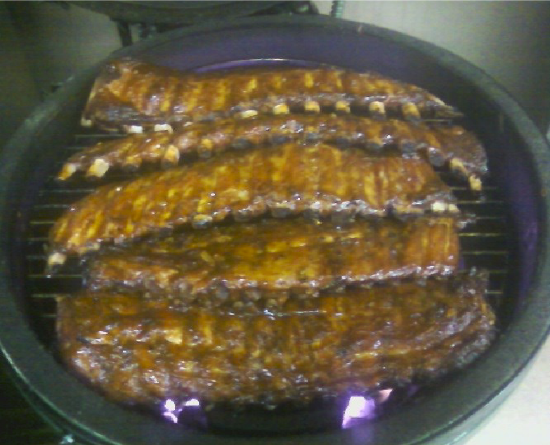
Canadian Bacon- Chef Marshall Welsh CEC Barbecued pork ribs- Chef Marshall Welsh CEC
Although not actually part of the primal loin, fatback is the thick layer of fat - sometimes more than an inch (2.5 centimeters) thick - between the skin and the lean eye muscle. It has a variety of uses in the kitchen, especially in the preparation of charcuterie items.
FRESH HAM
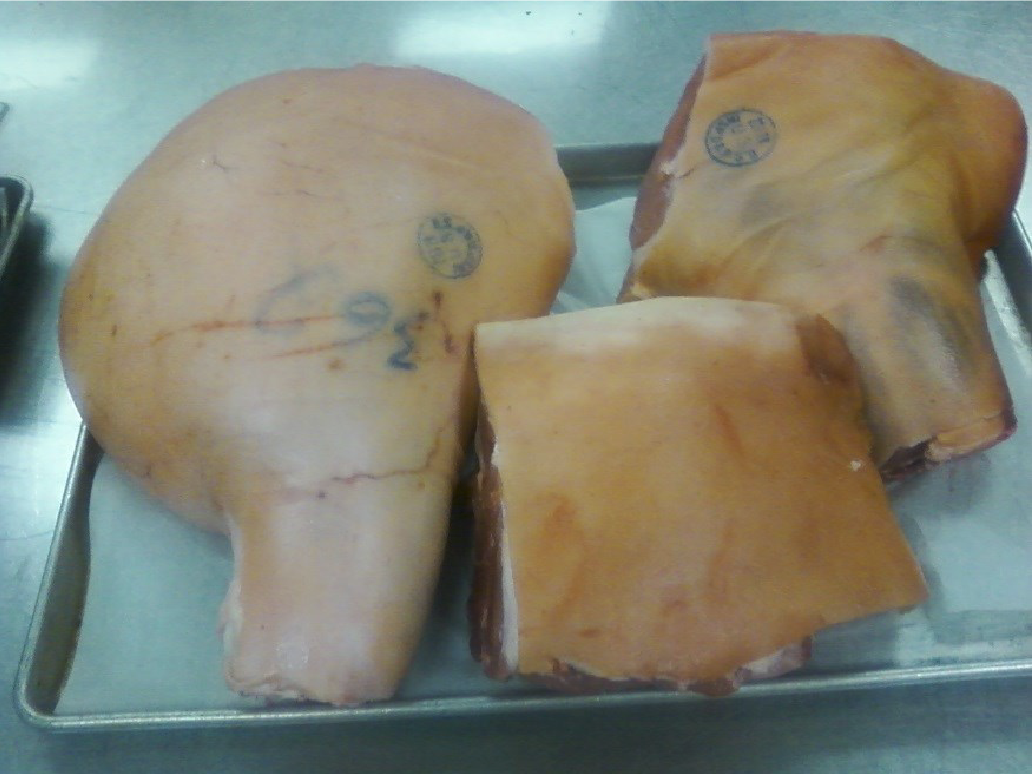
Fresh pork cuts from right to left: Ham, Boston Butt, and Picnic Shoulder Photo credit: Chef Marshall Welsh CEC
The primal fresh ham is the hog's hind leg. It is a rather large cut accounting approximately 24 percent of the carcass weight. The ham contains the aitch, and hind shank bones. Fresh ham, like the legs of other meat animals, contains large muscles with relatively small amounts of connective tissue. Like many other cuts of pork, hams are often cured and smoked. However, fresh hams also produce great roasts and can be prepared using almost any cooking method. When cured and smoked, hams are available in a variety of styles; they can be purchased bone-in, shankless or boneless, partially or fully cooked. Fully cooked hams are also available canned. There is a specific ham for nearly every use and desired degree of convenience. The shank portion of the ham is called the ham hock. It is used in the same manner as the shoulder hock.


